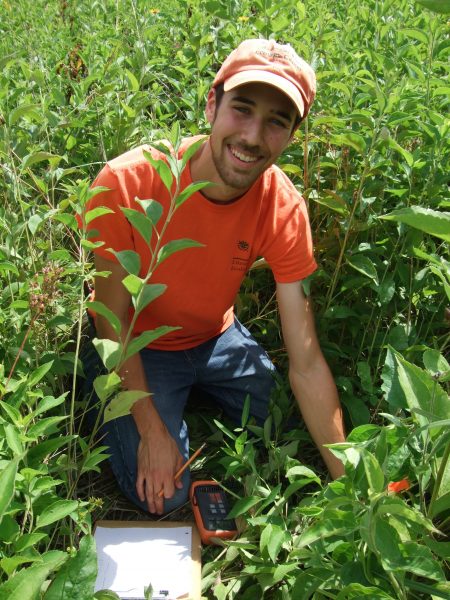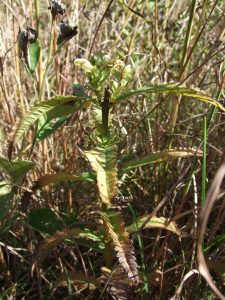
Sam Kilgore spent the summer with us as an intern, and, like Hannah Merwin (whose research you can find highlighted here), completed an independent research project over the course of his 10-week term. Sam hails from northern Illinois and graduated from Aurora University this past spring.
Sam had some experience working in prairie restorations before he came to LREC, and he knew that prairie restorations sometimes are dominated by certain grasses. Grasses such as big bluestem and Indian grass play important roles in a prairie, but sometimes they can take over too much and crowd out other plants. Sam had heard that hemiparasites (half-parasites that are able to produce their own energy through photosynthesis, but also rely on energy gathered from nearby plants through root suckers) might help increase the number of species in a prairie by weakening the dominant plants and improving conditions for other species to grow. He decided to see if he could find evidence of hemiparasites increasing plant species diversity in LREC prairies.
Swamp betony (Pedicularis lanceolata) is a hemiparasite that grows in the prairies at LREC, so Sam studied patches of prairie with a lot of swamp betony and patches with no swamp betony to compare the number of species and the quality of the species growing in these different areas. Sam measured the quality of the plants in a plot using a system of plant rankings that has been established to quantify how conservative a plant is in its growth needs. The more conservative a plant is (i.e., the more specific its needs for growing conditions are), the higher its plant quality ranking.

Sam found that while the number of different species in a plot was not related to the amount of betony in the plot, the quality of the species in the plot increased as the amount of betony increased. This means that areas with more betony tended to have plants with more specialized growing requirements. He did notice (but wasn’t able to directly measure) that the prairie plants in areas with betony were shorter than they were in areas without betony, most likely because the betony was using some of the other plants’ energy. In the areas he studied, Sam found a few plants (bottle gentian, spotted St. John’s wort, and partridge pea) that only grew in plots with betony. Since all these plants are short (usually less than 3 feet tall), they might depend on the betony to create shorter patches of prairie where they can thrive in the sunshine that would usually be blocked by tall prairie plants.
You can read more about Sam’s research in his paper or peruse the slides from his presentation: Betony and Biodiversity.
Next time you are in the prairie, look for patches where the plants are shorter and see if there is swamp betony growing there. Look at the other plants, too–maybe you’ll find something that doesn’t grow in many other places at LREC!